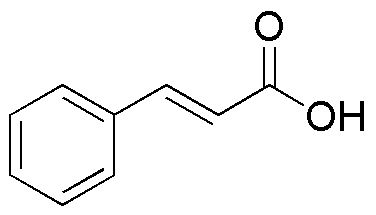Cinnamic acid is widely utilized in research focused on:
- Flavor and Fragrance Industry: Cinnamic acid is a key ingredient in the formulation of flavorings and fragrances, providing a sweet, spicy aroma that enhances products like perfumes and food additives.
- Pharmaceuticals: This compound is used in the synthesis of various pharmaceuticals, including anti-inflammatory and antimicrobial agents, making it valuable in drug development.
- Cosmetics: Cinnamic acid serves as a UV filter in sunscreens and skin care products, helping to protect skin from harmful UV radiation while providing antioxidant properties.
- Food Preservation: Its natural antimicrobial properties make cinnamic acid effective in food preservation, extending shelf life and maintaining food quality without synthetic additives.
- Polymer Industry: Cinnamic acid is used in the production of certain polymers and resins, contributing to materials with enhanced thermal stability and mechanical properties.
General Information
Properties
Safety and Regulations
Applications
Cinnamic acid is widely utilized in research focused on:
- Flavor and Fragrance Industry: Cinnamic acid is a key ingredient in the formulation of flavorings and fragrances, providing a sweet, spicy aroma that enhances products like perfumes and food additives.
- Pharmaceuticals: This compound is used in the synthesis of various pharmaceuticals, including anti-inflammatory and antimicrobial agents, making it valuable in drug development.
- Cosmetics: Cinnamic acid serves as a UV filter in sunscreens and skin care products, helping to protect skin from harmful UV radiation while providing antioxidant properties.
- Food Preservation: Its natural antimicrobial properties make cinnamic acid effective in food preservation, extending shelf life and maintaining food quality without synthetic additives.
- Polymer Industry: Cinnamic acid is used in the production of certain polymers and resins, contributing to materials with enhanced thermal stability and mechanical properties.
Documents
Safety Data Sheets (SDS)
The SDS provides comprehensive safety information on handling, storage, and disposal of the product.
Product Specification (PS)
The PS provides a comprehensive breakdown of the product’s properties, including chemical composition, physical state, purity, and storage requirements. It also details acceptable quality ranges and the product's intended applications.
Certificates of Analysis (COA)
Search for Certificates of Analysis (COA) by entering the products Lot Number. Lot and Batch Numbers can be found on a product’s label following the words ‘Lot’ or ‘Batch’.
*Catalog Number
*Lot Number
Certificates Of Origin (COO)
This COO confirms the country where the product was manufactured, and also details the materials and components used in it and whether it is derived from natural, synthetic, or other specific sources. This certificate may be required for customs, trade, and regulatory compliance.
*Catalog Number
*Lot Number
Safety Data Sheets (SDS)
The SDS provides comprehensive safety information on handling, storage, and disposal of the product.
DownloadProduct Specification (PS)
The PS provides a comprehensive breakdown of the product’s properties, including chemical composition, physical state, purity, and storage requirements. It also details acceptable quality ranges and the product's intended applications.
DownloadCertificates of Analysis (COA)
Search for Certificates of Analysis (COA) by entering the products Lot Number. Lot and Batch Numbers can be found on a product’s label following the words ‘Lot’ or ‘Batch’.
*Catalog Number
*Lot Number
Certificates Of Origin (COO)
This COO confirms the country where the product was manufactured, and also details the materials and components used in it and whether it is derived from natural, synthetic, or other specific sources. This certificate may be required for customs, trade, and regulatory compliance.


